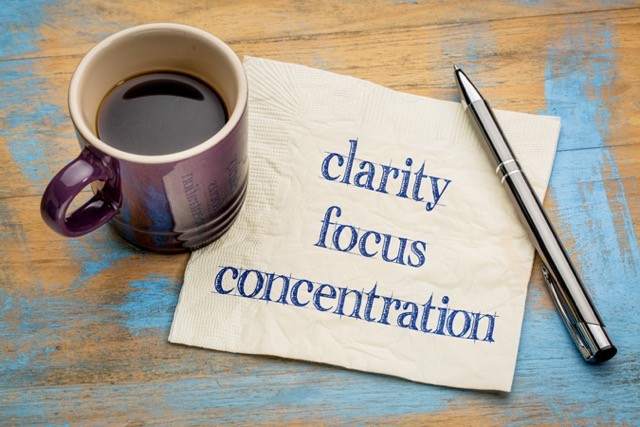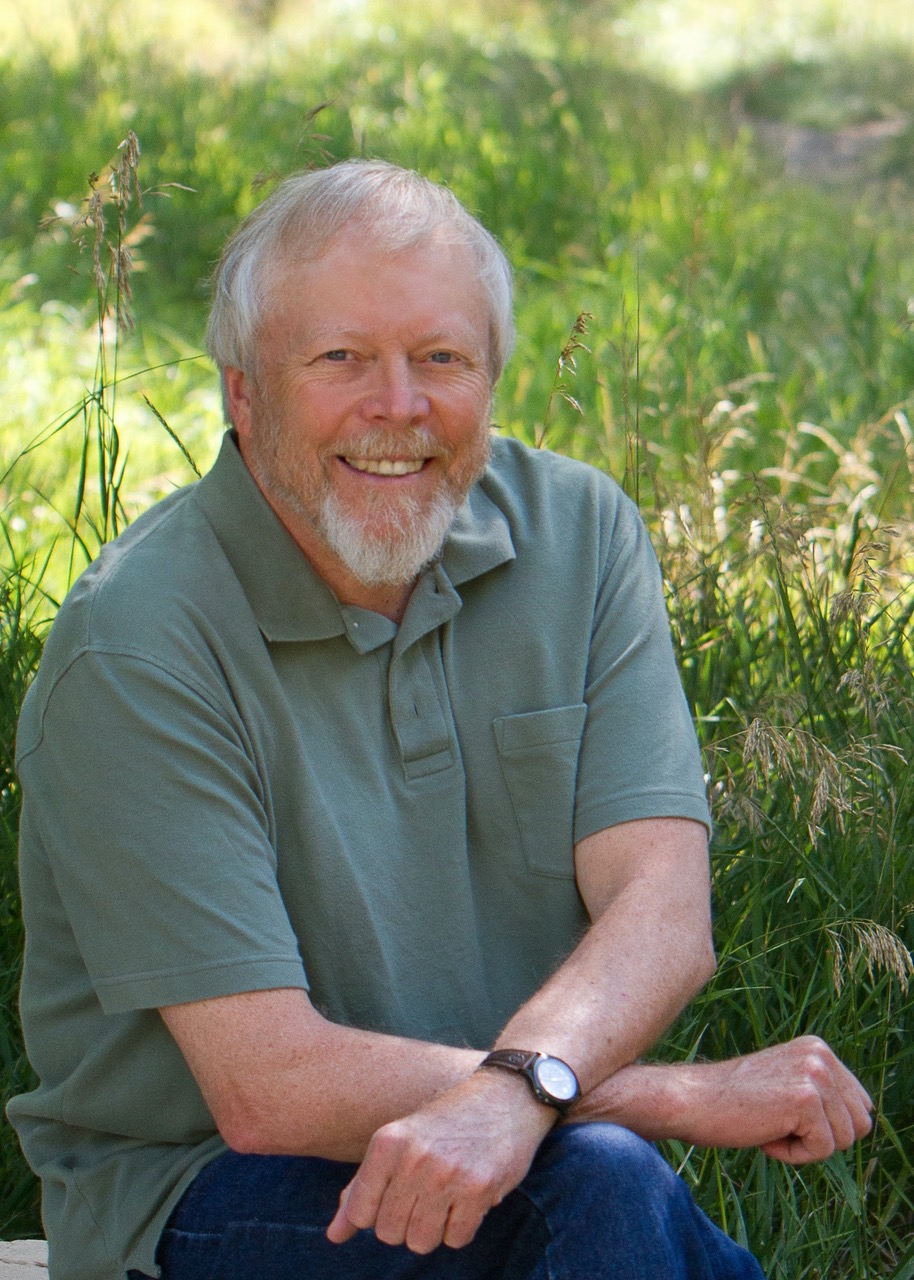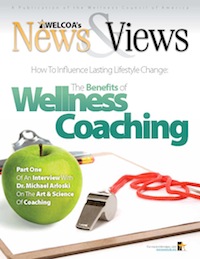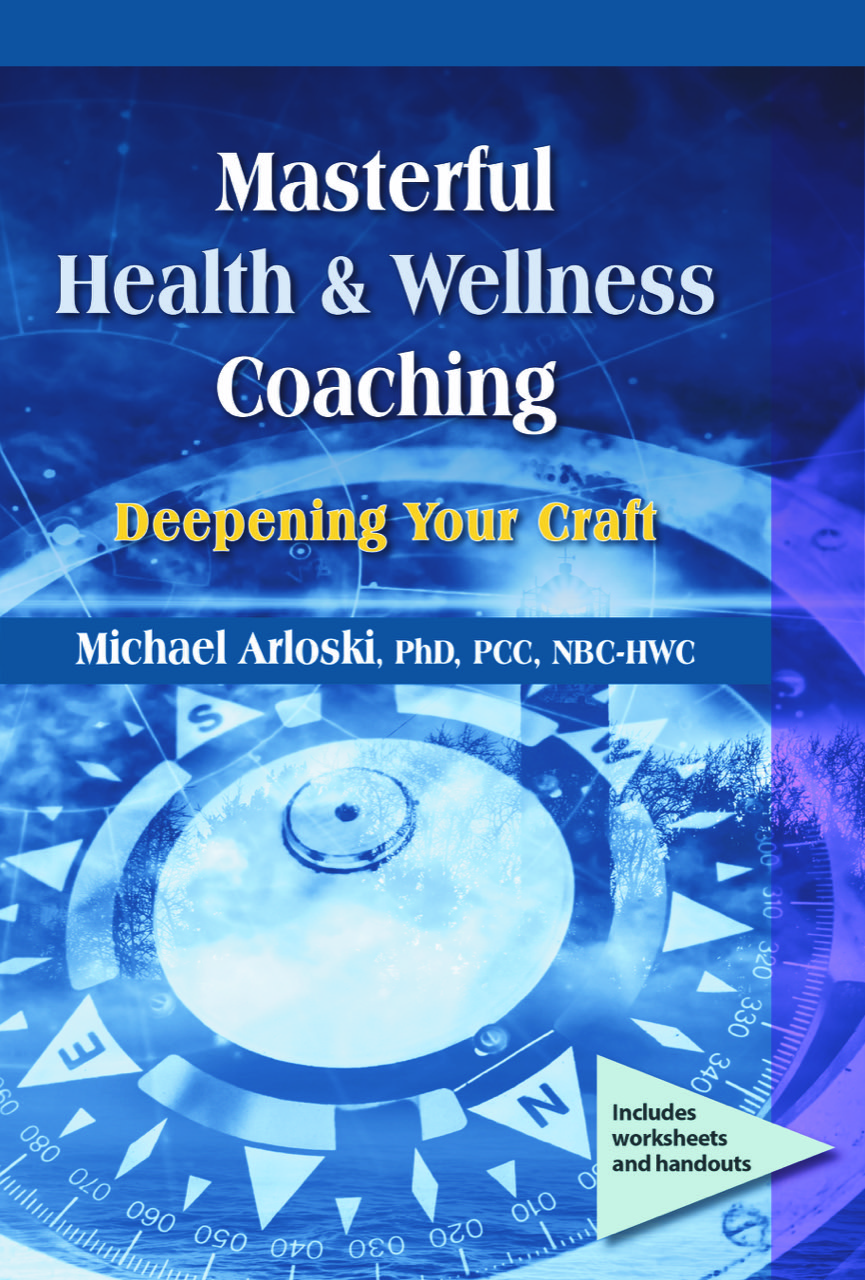FOCUS, FOCUS, FOCUS: The Art of Keeping Your Client on Track

Focus and simplicity...once you get there, you can move mountains.
Steve Jobs
What keeps a coaching session from being as productive as possible? While you can point the finger at a number of factors, lack of focus on the part of the client is often one. Coaching sessions that meander, that drift off into tangents, down rabbit holes and get lost ‘in the weeds’ of extraneous details seldom get where the client was hoping to go.
Helping our health and wellness coaching client to achieve and maintain focus is truly an art. The payoff is greater clarity, productivity and efficient use of what limited time we have together with our client. Let’s look at five important ways to develop that art:
- Session Structure
- Techniques to Deal with Tangents, etc.
- How Active Listening Skills enhance focus
- Trusting the Coaching Process
- Maintaining Forward Momentum
- COACHING STRUCTURE
Problem du Jour vs a Wellness Plan
The problem of the day. If coaching lacks structure it is easy to ask the client, “So! What would you like to talk about today?” Such an introduction to a session can invite a problem-solving approach and there always seem to be problems to solve. Thinking that coaching is solving one problem after another is an infinite challenge and keeps a negative focus to the process. Agreeing upon an agenda for the session right at the start can help both coach and client keep a holistic approach to the coaching process.
The time spent in co-creating the agenda for the session is well worth it. (ICF Core Competency #3 - Establishes and Maintains Agreements https://coachingfederation.org/wp-content/uploads/2021/07/Updated-ICF-Core-Competencies_English_Brand-Updated.pdf) In health and wellness coaching it can be even more complicated. While it seems a lot of life coaching, leadership and business coaching tends to set up sessions that have a single focus, health and wellness coaching (HWC) is different. Our HWC client is often working on a wellness plan that might include a number of Areas of Focus. While they may be working with a coach to achieve effective adherence to a treatment program (like taking medication on time, following up on appointments regularly, etc.) they also may be working on improving their connection with others to garner more support for their wellness efforts and working to increase their level of activity, and, at the same time attempting to improve their nutritional intake.
 This requires having a well-designed (through co-creation) Wellness Plan to work from. The Wellness Plan emerges after a process of exploration of the client’s strengths, assets, and challenges. It becomes the road map that the client can follow. Once you have a Wellness Plan in place you will never again have you and your client wondering what there is to talk about in a session. The destination of that map is the client’s vision of their best life possible: living their Well Life Vision.
This requires having a well-designed (through co-creation) Wellness Plan to work from. The Wellness Plan emerges after a process of exploration of the client’s strengths, assets, and challenges. It becomes the road map that the client can follow. Once you have a Wellness Plan in place you will never again have you and your client wondering what there is to talk about in a session. The destination of that map is the client’s vision of their best life possible: living their Well Life Vision.
Session Structure
Getting off to a good start is critical but keeping your client focused throughout the session means having each session contain a beginning, a middle and and end.
Part of creating the Coaching Alliance is educating clients in how coaching works. Yes, it is very client-centered but that doesn’t mean there is no structure. Clients are used to working with consultants not coaches. You tell a consultant as much information you can about a problem and wait for their expertise to come forward offering you solutions. Coaching is about facilitating the client with their own growth, helping them achieve what they want to achieve. So helping them understand the components of a coaching session is important:
- Greet and Connect
- Check-in on commitments from previous sessions
- Co-creating the agenda
- Processing
- Next Steps
- Closing
When, at all times during a session, you and your client need to know what we’re working on right now, clients find it so much easier to stay focused.
See my three-part blog series on Structuring Great Wellness Coaching Sessions (https://realbalance.com/structuring-great-wellness-coaching-sessions-part-one-how-to-get-started)( https://realbalance.com/structuring-great-wellness-coaching-sessions-part-2-process-and-progress)( https://realbalance.com/structuring-great-wellness-coaching-sessions-part-3-accountability-and-support?highlight=WyJzdHJ1Y3R1cmUiXQ==)
- TECHNIQUES TO DEAL WITH TANGENTS, ETC.
Associative Thinking
“Associative thinking is a cognitive process that allows the mind to connect seemingly unrelated concepts and ideas. This type of thinking is often described as a fast, subconscious process that links different memories, emotions, and physical sensations. Associative thinking is a natural and fundamental aspect of human experience, and it plays a crucial role in creativity and problem-solving.” (https://criticalthinkingsecrets.com/what-is-associative-thinking-and-why-does-it-matter-in-todays-workplace/#google_vignette) What an amazing and important function! Creativity leading to breakthroughs and finding solutions. Unfortunately it also can pave the way down rabbit holes and into the tangled lands of tangents. The focus on how to find more friends to be active with devolves into a story about our friend’s interest in old cars and we’re off on a ride down memory lane! What to do as we see our client getting off track and “into the weeds”?
Relevance and Respectful Interruption
Once a client takes off on a tangent the coaching conversation can start to look like a social conversation. The client’s tangent may go on and on even turning the conversation into a soliloquy.
When you detect a tangent in action gently nudge the client back on track by inquiring about relevance. Quickly insert a question when the client pauses (at all!). Begin with some sort of acknowledgement of what they have been saying – “It sounds like you have a passion for old cars too.’ Then quickly nudge by asking - “So, we were exploring how you could find friends to be more active with. Could you tell me how this relates to that goal?” Or you could simply nudge by reminding them of the focus – “So, we were exploring how you could find friends to be more active with” and just leave it at that.
If you find your own curiosity piqued by the topic of your client’s rabbit hole, put your own interest aside and don’t go down there with them! Yes, you’d love to know how to cook a delicious sounding dish but just don’t ask for details!
Yet, what does the coach do when confronted by a client who talks endlessly? Many of us have been taught to never interrupt someone. To do so is rude. Allowing the client to go on and on may not results in anything insightful or productive on the part of your client. Chances are good that they have a very talkative style and aren’t even aware of how much they are speaking. It is critical that a coach reclaim their part of the conversation. This is where the coach must find a respectful way to interrupt.
“Excuse me. I want to make sure I really understand what you’re saying…” Then the coach provides an accurate summarization of what they client has just said. Quickly, the coach follows this with a question, a request for clarification, or some other active listening skill. The summarization softens the interruption. The client usually feels heard and understood when they hear an effective summarization of what they have just said. The break in the action allows the coach to get themselves re-inserted into the conversation. Clients, even talkative ones, appreciate an actively involved coach. They usually feel as though they are getting more value out of the coaching when their coach is an active partner on the journey.
- HOW ACTIVE LISTENING SKILLS CAN ENHANCE FOCUS
From observation of hundreds of coaching recordings I’ve learned a very simple truth: when coaches don’t use Active Listening Skills enough their client ramble. Active Listening Skills actually have a built-in function of helping our clients stay more focused on what they are saying. Active Listening Skills aren’t really about how to listen, instead they give evidence to our client that we are listening and listening well. Our clients feel more heard and understood so they don’t have to say more seeking that understanding. When a client hears back to them an effective reflection, paraphrase or summarization of what they have said, two things happen: first, they realize they are being heard and understood, and this allows them to proceed further with what they are saying and secondly what they are hearing back to them is essentially the essence of what they have said. This causes them to hear a focused condensation of what they have said helping them arrive at more clarity and suspends the need for more words of explanation.
As coaches gain more coaching experience and education they sometimes discount simple Active Listening Skills and become enamored with “powerful questions.” William Miller (as in Miller & Rollnick) suggests using two or even three Active Listening Skills for every one question. Never underestimate the value of good old, Active Listening Skills.
- TRUSTING THE COACHING PROCESS
 Coaches are only human. We can get impatient with a client who seems to take forever to “get to the point”, or with the client who struggles to find a path forward that works for them. This is when we can be tempted to leave the Coaching Mindset (Making and Maintaining The Shift To The Coaching Mindset https://realbalance.com/making-and-maintaining-the-shift-to-the-coaching-mindset?highlight=WyJtaW5kc2V0Il0=) and become the expert consultant. We can start to do the work for our client instead of facilitating their work. We know all sorts of ways to be healthy and well, why not just prescribe a few like our clients are sometimes pleading for us to do?
Coaches are only human. We can get impatient with a client who seems to take forever to “get to the point”, or with the client who struggles to find a path forward that works for them. This is when we can be tempted to leave the Coaching Mindset (Making and Maintaining The Shift To The Coaching Mindset https://realbalance.com/making-and-maintaining-the-shift-to-the-coaching-mindset?highlight=WyJtaW5kc2V0Il0=) and become the expert consultant. We can start to do the work for our client instead of facilitating their work. We know all sorts of ways to be healthy and well, why not just prescribe a few like our clients are sometimes pleading for us to do?
If we fall into that trap, perhaps thinking It will save a lot of time, we start inquiring more and more about the challenges they are facing to gain information for us to process and make recommendations. As we guide the client where we want to go, the client can become more and more passive, and potentially more disengaged. Less engagement, less focus on their part. You, the coach are becoming more and more focused but are you bringing the client along with you?
If you are truly facilitating the client’s work, helping them gain greater understanding, awareness and insight they become more focused, and you don’t need to know all of the details of what they are dealing with. They know. You don’t have to.
I’ve conducted three Real Balance Health and Wellness Coach Trainings in Dublin, Ireland. Once as we came to the last hour of a long intensive training I actually had time to conduct another coaching demonstration. The only volunteer willing at the end of a that long week was the one woman in the group whose Dubliner accent was so thick that the other Irish couldn’t even understand her well. And, she spoke a thousand miles per hour. I took a deep breath, trusted that facilitating her work was what the demo was all about and went for it! The session was terrific! She gained insight and found a way forward that she was very, very pleased with. Even though I had not understood a full one third of what she said, it didn’t matter. It was grand! Trust the coaching process.
- MAINTAINING MOMENTUM
Forwarding the Action
You and your client are moving ahead, shall we say, expeditiously! You’ve been doing all the best things described already in this piece: using coaching structure; co-creating agreements; operating from a coaching mindset; using active listening skills effectively; nudging your client back from tangents, etc. Your client is learning about themselves, gaining insights and realizations, now to apply it and to maintain this forward momentum!
The real behavior change does not happen in the coaching session. It’s not like treatments where you get up off the table and the treatment has been done. The real behavior change happens out there in the client’s life, in between coaching appointments.
This is where we help our client to set up “action” steps that are appropriate to the Stage of Change that they are in for that particular behavior. (Changing to Thrive)(https://www.simonandschuster.com/books/Changing-to-Thrive/James-O-Prochaska/9781616496296). The exploration in the coaching session has helped them realize that a large part of their sedentary lifestyle has to do with lacking anyone to be more active with. They may not be ready to run right and find a new best friend. Perhaps they need to Contemplate more about it. There may be fears of rejection holding them back that they need to explore more. Perhaps they need to Prepare more by finding out about resources where they can meet people who share some of their activity interests. Remember the Prochaska’s research showed that people are ready to jump into the Action Stage of a particular behavior only 20% of the time.
You can help Forward the Action by exploring with your client by asking two key questions about any “action” step being considered:
- What are you concerned will happen if you do this?
- Who/what else can support you in doing this?
Process these two questions with your client as you agree upon the Next Steps part of the coaching session. Take a look at my blog about coaching around fears (Coaching About Fear: A Wellness Coaching Perspective https://realbalance.com/coaching-about-fear-a-wellness-coaching-perspective?highlight=WyJzdGFnZXMiLCJvZiIsImNoYW5nZSJd), and about Coaching for Connectedness (Coaching for Connectedness – Part One: Why it’s Important https://realbalance.com/the-importance-of-coaching-for-connectedness?highlight=WyJjb25uZWN0ZWRuZXNzIl0=) (Coaching for Connectedness – Part Two: How to Coach for Greater Connection and Belonging https://realbalance.com/coaching-for-connectedness---part-two-coaching-for-greater-connection?highlight=WyJjb25uZWN0ZWRuZXNzIl0=)
“Always remember, your focus determines your reality.”
George Lucas

Michael Arloski, Ph.D., PCC, NBC-HWC is CEO and Founder of Real Balance Health Coach Training (https://realbalance.com/). Doctor Arloski is a psychologist, coach and pioneering architect of the field of health and wellness coaching. He and his company have trained thousands of coaches around the world.








Only registered and logged in readers can leave comments.